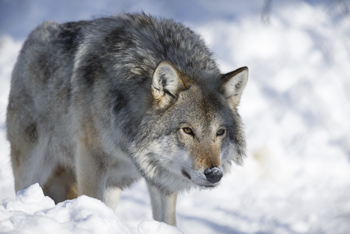 Dec. 23, 2014 – Permits that allow the lethal removal of wolves by landowners in Wisconsin are no longer valid, according to the Wisconsin Department of Natural Resources, responding to a federal court decision that protects wolves in the region.
Dec. 23, 2014 – Permits that allow the lethal removal of wolves by landowners in Wisconsin are no longer valid, according to the Wisconsin Department of Natural Resources, responding to a federal court decision that protects wolves in the region.
Last week, a judge for the U.S. District Court for the District of Columbia vacated rules – promulgated by the U.S. Fish and Wildlife Service (FWS) in 2012 – that removed federal endangered species protections for wolves in the Western Great Lakes region.
FWS took delist action through a final rule that said wolves in the Western Great Lakes region, known as “eastern wolves,” were genetically different from endangered gray wolves, and were sufficiently populated in the region to be delisted as endangered.
Wisconsin and Michigan, as intervenors, defended FWS’s 2012 delisting in a lawsuit filed by the Humane Society of the U.S. and other wolf conservation groups.
But in Humane Society of the U.S. et al. v. Wisconsin et al., the district judge ruled that removing these wolves from the endangered list was “arbitrary and capricious,” which means the DNR and authorized landowners can no longer kill wolves in Wisconsin.
The judge said the FWS could not reclassify protected wolves in order to delist them, and the record evidence did not support a delisting under the Endangered Species Act.
“Contrary to the agency’s position, this approach of using a [distinct population segment] designation to delist a population of a broader listed species is not consistent with the purposes of the [Endangered Species Act],” wrote Judge Beryl Howell.
In vacating the delist rule on wolves in the Great Lakes region, Judge Howell said the Endangered Species Act “reflects the commitment by the United States to act as a responsible steward of the Earth’s wildlife, even when such stewardship is inconvenient or difficult for the localities where an endangered or threatened species resides.”
The 111-page opinion notes that wolf eradication nearly wiped out gray wolf populations in the lower 48 states by the 1930s. But early federal laws only protected specific gray wolf subspecies, such as the timber wolf, not gray wolves as an entire species.
In 1978, though, the entire gray wolf species was classified as endangered in all lower 48 states except Minnesota, where the gray wolf was listed as “threatened.”
Meanwhile, gray wolf recovery efforts aimed to reintroduce gray wolf populations in geographic areas where they had been largely eradicated, including Wisconsin.
Starting in 2000, the Fish and Wildlife Service proposed rules that would delist certain gray wolf populations by geographic segment, but repeatedly failed.
Wisconsin has repeatedly applied for permits to kill set numbers of endangered wolves in the last decade through sport hunting and trapping, and supported the latest attempt for delisting in the region, which has an estimated wolf population of 3,700.
But the judge in D.C. said the FWS failed to adequately explain its rulemaking decision in light of evidence, including “how the state management plans permitting the unlimited killing of wolves in certain areas, which FWS admits will result in the deaths of hundreds of gray wolves, does not constitute a threat to the species.”
